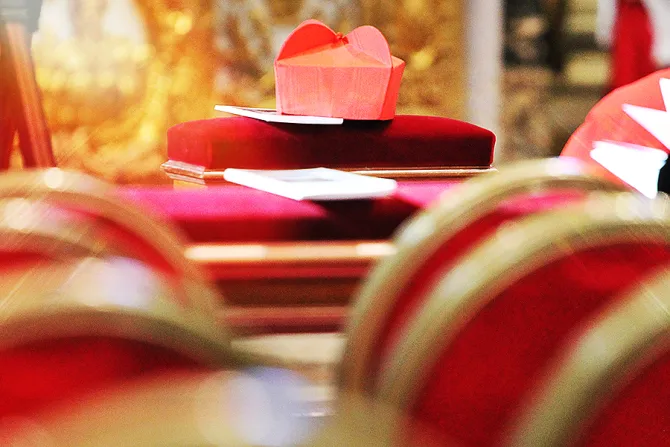Rome, Italy, Nov 18, 2016 / 15:26 pm
In a simple rite this Saturday, 17 prelates will receive a red biretta from Pope Francis and thus join the College of Cardinals.
Dressed in their red robes, the cardinals-to-be will gather in St. Peter Basilica, profess the Creed, and then approach Pope Francis one by one. The Pope will give each of them the red biretta, and their cardinal's ring
The Pope will place the red hat on each cardinal's head and say:
"To the glory of almighty God and the honor of the Apostolic See, receive the scarlet biretta as a sign of the dignity of the cardinalate, signifying your readiness to act with courage, even to the shedding of your blood, for the increase of the Christian faith, for the peace and tranquility of the people of God and for the freedom and growth of the Holy Roman Church."
As he places the ring on a new cardinal's finger, the Pope will say: "Receive this ring from the hand of Peter and know that, with the love of the Prince of the Apostles, your love for the Church is strengthened."
Each cardinal will be assigned a titular church. This is an important act, as the cardinals must be a part of the Diocese of Rome, whose bishop and primate is the Pope. This means cardinals are always linked to Rome, though they come from different countries.
The College of Cardinals reflects how the Synod of the Diocese of Rome evolved to become a governmental body. It is an institution that can be simply considered as "the Pope's Senate."
Cardinals are now part of Vatican Congregations and dicasteries, and in that capacity they help the Pope to govern the Church. This was not always the case.
During the Middle Ages, consistories were convoked any time the Pope had to make an important decision. The meeting of cardinals also served as a tribunal. In the twelfth century, Pope Alexander III scheduled one consistory per month. Not long after Alexander III's pontificate, Pope Innocent III scheduled three meetings per week.
In the 16th century, under Pope Sixtus V's curial reforms, the consistory lost some of its power. Ever since, cardinals mainly assist the Pope in governing the Church and working in Vatican congregations. The consistory is convoked to give a particular solemnity to important moments of the Church.
The rite of the consistory was reformed in 1969 by Blessed Paul VI. The reform gave a liturgical framework to the creation of a new cardinal, though the event had not previously been seen as a liturgical moment.
Pope Paul's changes elaborated a rite that put the imposition of the red biretta in a context of prayer. He thus gave a spiritual bond to the cardinals' intimate union with the Pope.
Father Gianfranco Grieco, a former writer for L'Osservatore Romano who covered all the Paul VI's international trips, recounted in his book "Paul VI" that the Pope used to convoke a consistory any time he came back from an international trip. He would report his impressions from the trip and exchange opinions with the cardinals.
The rite for the consistory was reformed and simplified by Pope Benedict XVI in 2012, while maintaining Paul VI's vision of a liturgical framework for the creation of new cardinals.
Benedict XVI took from Paul VI's rite two prayers of the cardinals that refer to the powers God has given to the Church, and especially to the successor of Peter. The successor of Peter, in turn, prays for himself, asking that he will be able to rightly fulfil his office.
Consistories have still had key roles in the life of the Church. Benedict XVI announced his historic resignation of the Petrine ministry on Feb. 11, 2013, during a Consistory for the Canonization of the Martyrs of Otranto.
As for Pope Francis, he has used the consistory as a sort of "advisory board" on core issues.
The Feb. 22, 2014 consistory was preceded by an extraordinary consistory on the issues of the family. It was opened with a speech from Cardinal Walter Kasper that set the tone of the discussion ahead of the two synods on the family.
Pope Francis convoked another extraordinary consistory Feb. 12-13, 2015 to discuss Curia reform, ahead of the Feb. 14-15 consistory for the creation of new Cardinals.
It is noteworthy that the Code of Canon Law, reformed in 1983, lays out two forms of consistory: ordinary and extraordinary. An extraordinary consistory is celebrated in particular cases, and all the cardinals are called to take part in it. An ordinary consistory takes place when the Pope needs the cardinals' counsel on some important, though normal, issue, or to give solemnity to the Pope's decision, such as the approval of the canonization of saints.
Kevin J. Jones contributed to this report.



